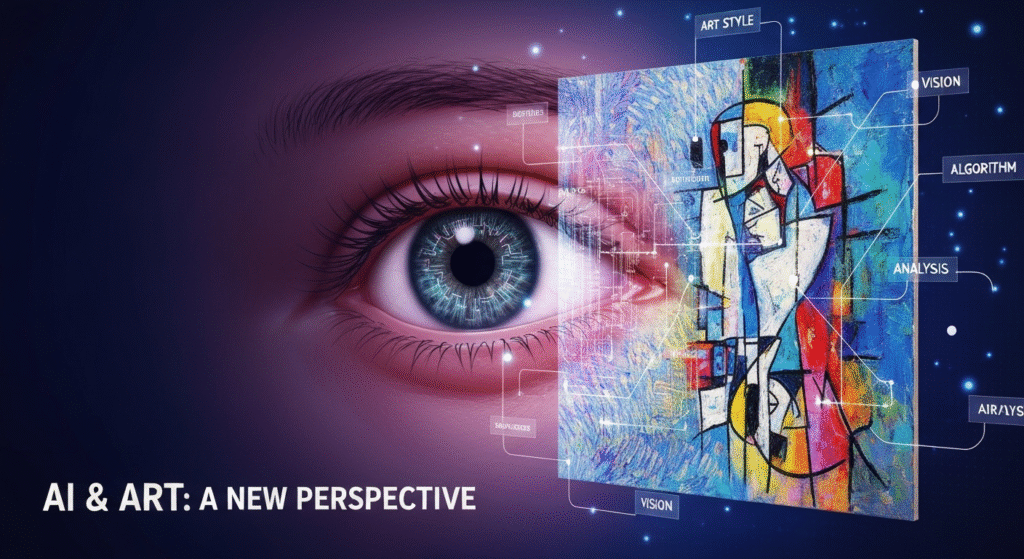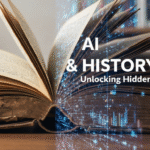Have you ever stood in a museum, stared at a painting, and wondered what makes it a “masterpiece”? We talk about brushstrokes, composition, and emotion. But have you ever asked yourself how a computer would see that same painting? Not as a collection of feelings and history, but as pure data. That question recently sent me down a fascinating rabbit hole. I wanted to see art through a machine’s eyes, to understand how Artificial Intelligence identifies different art styles. This wasn’t about replacing the human experience but about adding a new, incredibly logical layer to it.
I decided to run my own experiments, feeding famous artworks to different AI models to see what they would spit back out. The results were more than just a list of labels; they were a revelation. This journey became a personal course in computer vision, teaching me to see the patterns, textures, and color palettes that a machine uses to classify a Monet from a Mondrian. Let’s break down what I learned, the surprising moments, and how this technological exploration gave me a deeper appreciation for the human genius behind the canvas.
As an author, my name is Zain Mhd, and for the past several years, I’ve been fascinated by the intersection of AI and human culture. My goal has never been just to understand the code but to see how these new technologies reshape our world and our understanding of it. I don’t come from a formal art history background, but my passion for AI has given me a unique lens through which to explore creative fields. This project was born from pure curiosity—a desire to connect the dots between algorithms and aesthetics and to share what I found in a way that anyone can understand.
The Big Question: How Does a Machine Even “See” Art?
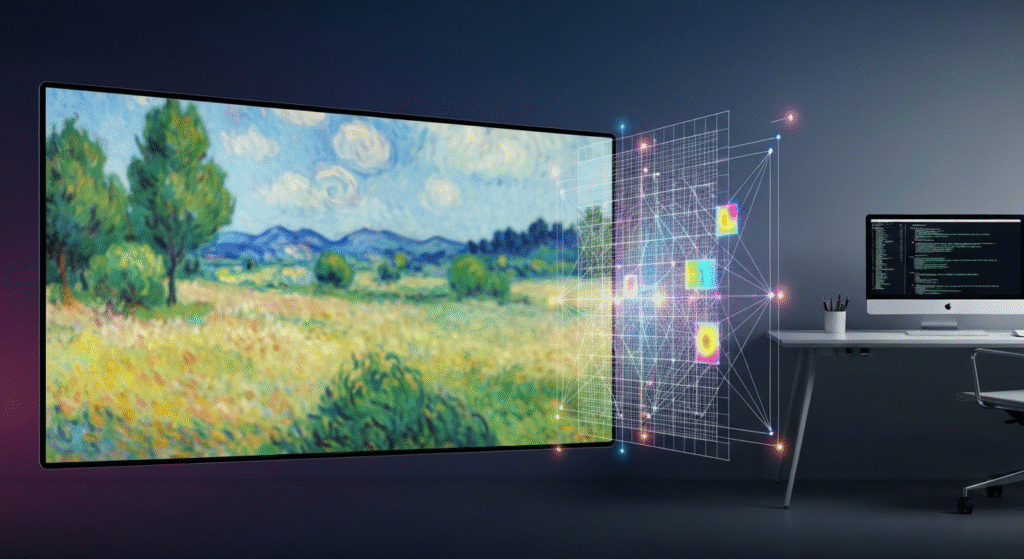
Before I could test anything, I had to understand the basics. How does an AI, which is essentially just a complex set of mathematical functions, “look” at a painting? A human sees a serene landscape in a Claude Monet painting. A computer sees a grid of millions of pixels, each with a specific color value (RGB code). The magic isn’t in seeing the pixels but in recognizing the patterns they form. This is the core of computer vision.
The primary technology behind this is a type of AI called a Convolutional Neural Network (CNN). It sounds complicated, but the concept is surprisingly intuitive. Let’s use an analogy. Think about how you learned to recognize a cat. You weren’t given a textbook definition. You were shown examples. You learned to spot key features: pointy ears, whiskers, a long tail, a certain way of moving. A CNN learns in a similar way, but for images.
It breaks an image down into tiny pieces and scans for simple features like edges, corners, and colors. Then, it combines these into more complex features, like textures or shapes.
- Layer 1: Detects basic edges and color gradients.
- Layer 2: Combines edges to find simple shapes (circles, squares).
- Layer 3: Combines shapes to recognize textures (like the rough texture of oil paint on canvas or the distinct dab of a Pointillist painter).
- Final Layer: Assembles all these recognized features to make a final prediction: “This pattern of features is 85% likely to be ‘Impressionism’.”
The AI isn’t “seeing” a boat on the water. It’s identifying a statistical pattern of short, thick brushstrokes and a specific light-scattering effect that it has been trained to associate with the “Impressionism” label. This realization was my starting point—I wasn’t just testing an app; I was exploring how a machine learns a visual language.
Setting Up My Experiments: Putting the AI’s Eye to the Test
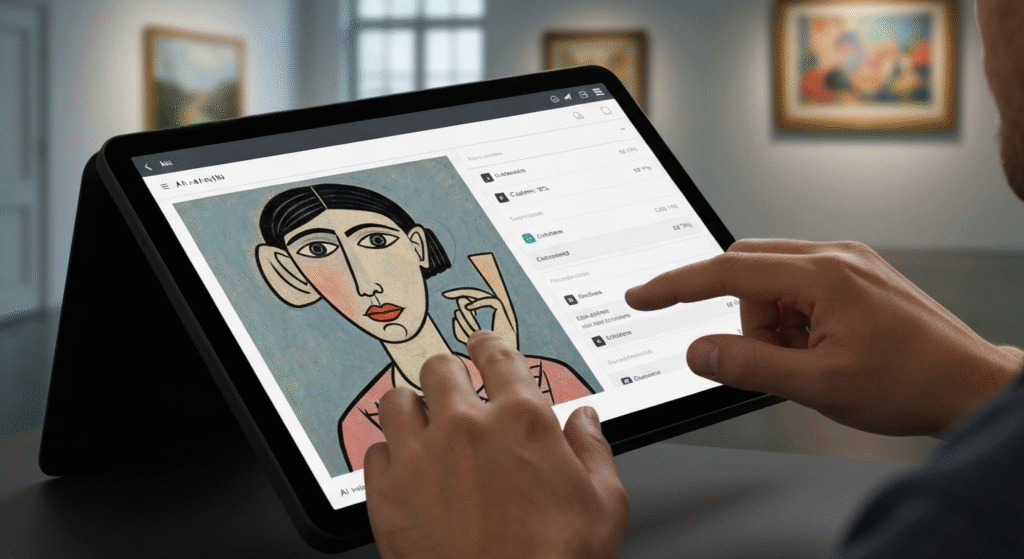
With a basic understanding of the theory, I was ready to get my hands dirty. I wanted to see how this worked in practice. I didn’t need a supercomputer; many powerful computer vision tools are accessible to anyone with an internet connection. I primarily used Google’s Vision AI and a few open-source models available online to see if their results varied.
My method was straightforward:
- Gather a Diverse Dataset: I collected high-resolution images of paintings from various, clearly defined art movements. I wanted to cover the classics and also throw in some curveballs.
- Start Simple: I began with styles that have very distinct visual characteristics.
- Increase Complexity: I then moved on to more nuanced styles that even humans sometimes have trouble differentiating.
- Document Everything: I recorded the AI’s top guess, its confidence level, and any other labels it provided.
The Obvious Tests: Impressionism vs. Cubism
My first test was a classic showdown: Claude Monet’s Impression, Sunrise versus Pablo Picasso’s Weeping Woman. For a human, these are worlds apart. Monet’s work is soft, hazy, and focused on light. Picasso’s is sharp, fragmented, and emotionally jarring.
The AI passed with flying colors. For Monet, it returned labels like “Impressionism,” “Watercolor paint,” and “Atmosphere.” It correctly identified the stylistic fingerprints—the fuzzy edges and blended colors. For Picasso, it confidently identified “Cubism,” “Art,” and “Visual arts.” It locked onto the geometric shapes, the fragmented perspective, and the sharp lines that define the style. This initial success showed me that, for highly distinct styles, the AI had learned its lessons well.
Pushing the Boundaries: Abstract Expressionism vs. Surrealism
Next, I wanted to give the AI a real challenge. How would it handle styles that are less about technique and more about concept or emotion? I chose Jackson Pollock’s chaotic drip paintings (Abstract Expressionism) and Salvador Dalí’s dreamlike landscapes (Surrealism).
Here, the results got more interesting.
- With Pollock’s work, the AI immediately identified labels like “Modern art” and “Painting.” However, it struggled to pin down “Abstract Expressionism” as its top result consistently. Sometimes, it would simply return “Pattern” or “Art,” showing it recognized the visual complexity but lacked the contextual “knowledge” to classify the movement itself. It saw the “what” (the drips and lines) but not the “why” (the artistic intent).
- With Dalí’s melting clocks, the AI performed surprisingly well. It identified “Surrealism” with high confidence. My theory is that while the concept is surreal, the objects themselves (clocks, landscapes) are often rendered with realistic detail. The AI could latch onto these recognizable forms, even in their bizarre arrangements, making it easier to classify than Pollock’s pure abstraction.
This experiment highlighted a key finding: the AI is at its best when a style has consistent, repeatable visual textures and patterns. It gets confused when the style is more about the idea behind the art than the physical application of paint.
| Art Style Tested | Sample Artwork | AI’s Top Prediction | Confidence Score | My Observations |
| Impressionism | Monet’s Impression, Sunrise | Impressionism | 92% | Easily identified due to the characteristic blurry brushstrokes and focus on light. |
| Cubism | Picasso’s Weeping Woman | Cubism | 95% | The AI quickly locked onto the geometric fragmentation and sharp, angular lines. |
| Surrealism | Dalí’s The Persistence of Memory | Surrealism | 88% | Successfully identified the style, likely because it could recognize the realistically painted objects despite their surreal context. |
| Pointillism | Seurat’s A Sunday on La Grande Jatte | Pointillism | 75% | It correctly identified the style but with lower confidence. It also suggested “Impressionism,” showing it saw the connection. |
| Abstract Expressionism | Pollock’s No. 5, 1948 | Modern Art | 85% | It struggled to name the specific movement, often defaulting to broader terms like “Modern Art” or even just “Pattern.” |
| Pop Art | Warhol’s Campbell’s Soup Cans | Pop Art | 98% | A huge success. The AI easily recognized the graphic, commercial style and bold, flat colors. |
Where the AI Shined and Where It Stumbled
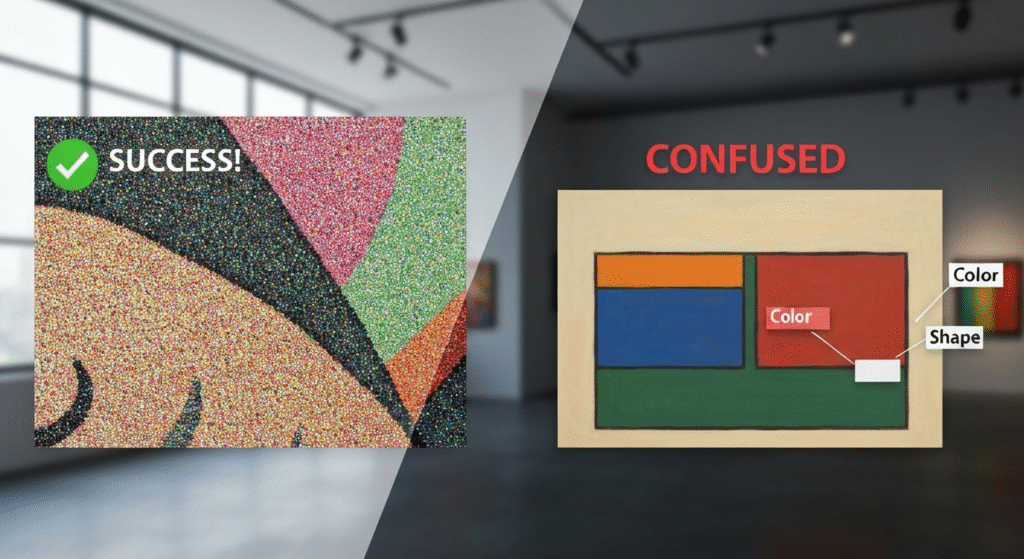
Every experiment had its share of “aha!” moments and a few head-scratchers. Some of the AI’s successes were so specific they felt like magic, while some of its failures were comically literal.
One of the most impressive successes came when I tested Pointillism, using Georges Seurat’s famous park scene. I expected the AI to lump it in with Impressionism, as the two are closely related. Instead, its top result was “Pointillism,” with “Impressionism” as a secondary label. It was smart enough to recognize the parent movement but also specific enough to see the unique technique of using tiny dots of color. It was like it had a micro-level view of the canvas that I often overlook.
However, the failures were just as insightful. I showed it a piece of minimalist art by Mark Rothko, which features large, rectangular blocks of color. The AI’s top suggestions included:
- “Rectangle”
- “Orange”
- “Textile”
- “Red”
It completely missed the “Color Field painting” or “Abstract” labels. It saw the component parts—the shapes and colors—but had zero concept of the artistic whole. It was a perfect demonstration of the AI’s biggest weakness: its lack of context. It can’t grasp that two blocks of color on a canvas can be a profound piece of art, because it has no understanding of the artist’s intent, the historical movement, or the emotional impact. It just sees a rectangle.
What AI Taught Me About My Own Perception
This journey started as a tech experiment, but it ended up changing how I look at art. By trying to understand the AI’s logic, I had to break down art into its fundamental visual elements, just like the machine does. When I look at a Van Gogh now, I don’t just see a swirling sky; I also see the textural data in his thick, impasto brushstrokes—the very pattern the AI would latch onto.
The process forced me to move beyond my initial emotional reaction and analyze the mechanics of a style. What makes something look “Impressionistic”? It’s a combination of a specific color palette, a certain brush technique, and a way of depicting light. The AI quantifies this. It builds a mathematical model of a style, which is a completely different way of thinking about something so inherently human.
Here’s a comparison of how I learned to see the two approaches:
| Aspect of Analysis | 🎨 Human Perception | 💻 AI Computer Vision |
| Brushstrokes | We feel the energy and emotion in a frantic brushstroke or the peace in a smooth one. | It measures the length, thickness, and direction of strokes, identifying them as a repeatable texture or pattern. |
| Color | We associate colors with moods—blue for sadness, yellow for joy. We see how colors harmonize. | It analyzes the color palette, calculating the dominant hues and their statistical distribution across the image. |
| Composition | We understand concepts like balance, focus, and narrative flow within the frame. | It identifies the placement of major shapes and lines but has no understanding of visual hierarchy or storytelling. |
| Context & Meaning | We bring knowledge of the artist’s life, the historical period, and cultural symbolism to our interpretation. | It operates in a vacuum. A symbol is just a shape; a portrait is just a collection of facial features. |
| Emotion | We can feel the despair in a Picasso or the tranquility in a Monet. | It cannot process or understand emotion. It can only classify a style that other humans have labeled as “emotional.” |
The AI is not a rival to human perception; it’s a different kind of tool. It’s like having a microscope to see the technical DNA of a painting, even if it can’t understand the soul.
The Bigger Picture: A New Tool for Art and Education
So, what are the real-world implications of this technology? It’s more than just a party trick for identifying paintings. I believe AI art recognition has huge potential, especially in education. Imagine an app that art students could use in a museum. They could point their phone at a painting and get an instant analysis of its stylistic elements, breaking down the brushwork and color theory in real-time. It could make art history more interactive and accessible. For a deep dive into how AI is being used in cultural heritage, check out the work being done at MIT’s Computer Science and Artificial Intelligence Laboratory (source).
This technology can also be a tool for artists. An artist could use it to analyze their own work, getting objective feedback on their stylistic consistency or even using it to generate ideas by blending the mathematical patterns of two different styles.
Of course, we must remember its limits. An AI can tell you that a painting is Surrealism, but it can’t tell you why Salvador Dalí painted melting clocks or what they represent. It can identify the techniques of the masters, but it can’t replicate their creativity or their vision. The human element—the story, the emotion, the historical context—remains irreplaceable.
Frequently Asked Questions
Can AI understand the meaning behind a painting?
No. AI can identify patterns and objects, but it lacks the ability to understand context, symbolism, or the artist’s intent. It can classify a style, but it cannot interpret meaning.
Are AI art identifiers always accurate?
Not always. They are highly accurate with distinct, well-defined styles but can struggle with nuanced, abstract, or minimalist art. Their accuracy depends heavily on the quality and diversity of the data they were trained on.
What is the best AI tool for identifying art styles?
There isn’t one “best” tool. Major platforms like Google Vision AI and Microsoft Azure Cognitive Services offer powerful image analysis. There are also specialized apps and websites, but their performance can vary. The key is to try a few and see which works best for your needs.
Could AI replace art historians?
It’s highly unlikely. AI is a powerful analytical tool that can assist with tasks like cataloging and style identification, but it cannot perform the critical, contextual, and interpretive analysis that art historians do. It’s a tool to augment their work, not replace it.
Conclusion: A New Lens on an Old World
My dive into the world of AI art recognition was more rewarding than I ever expected. I started with a simple technical question and came away with a fundamentally new way of looking at art. The cold, hard logic of the machine, with its focus on patterns and data, gave me a new appreciation for the elements of style that I had always felt but never consciously analyzed. It showed me the hidden mathematical beauty behind the emotional facade of a painting.
In the end, this technology doesn’t diminish the magic of art. It adds to it. It proves that a masterpiece is so much more than a collection of well-executed patterns. AI can see the “how,” but only a human can truly understand the “why.” And by using these tools to see like a machine, we can learn to appreciate the miracle of human creativity even more.
